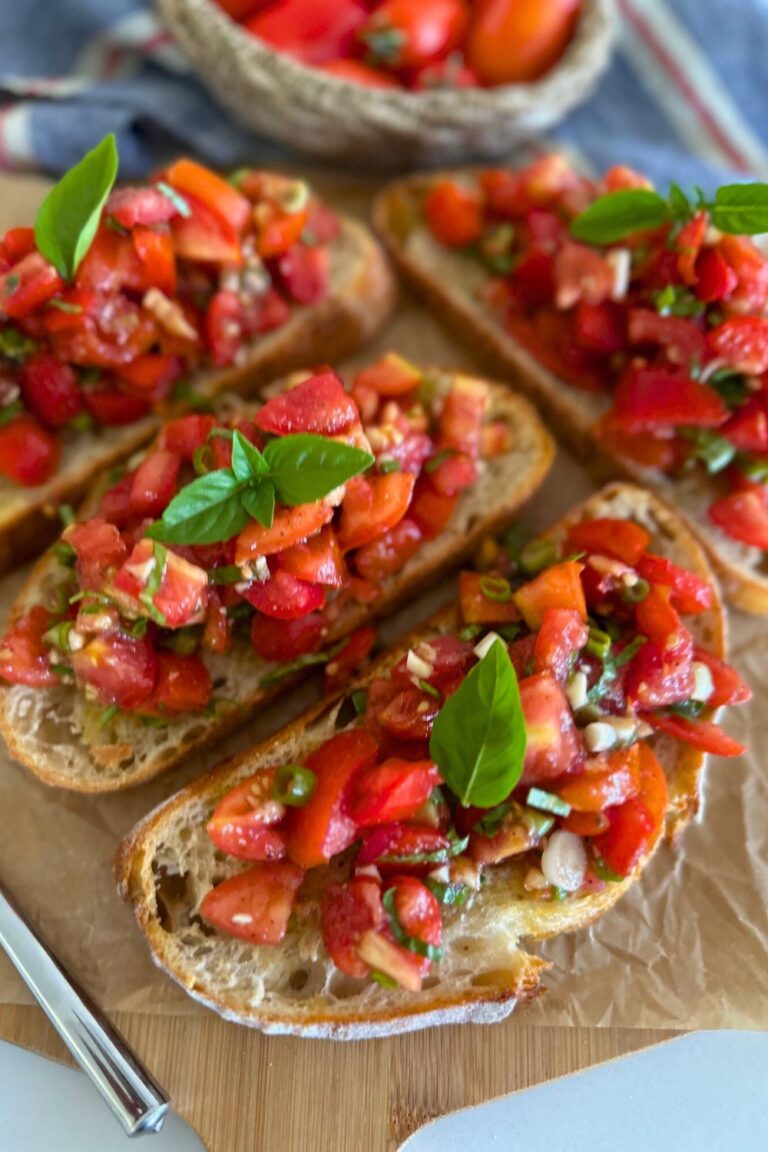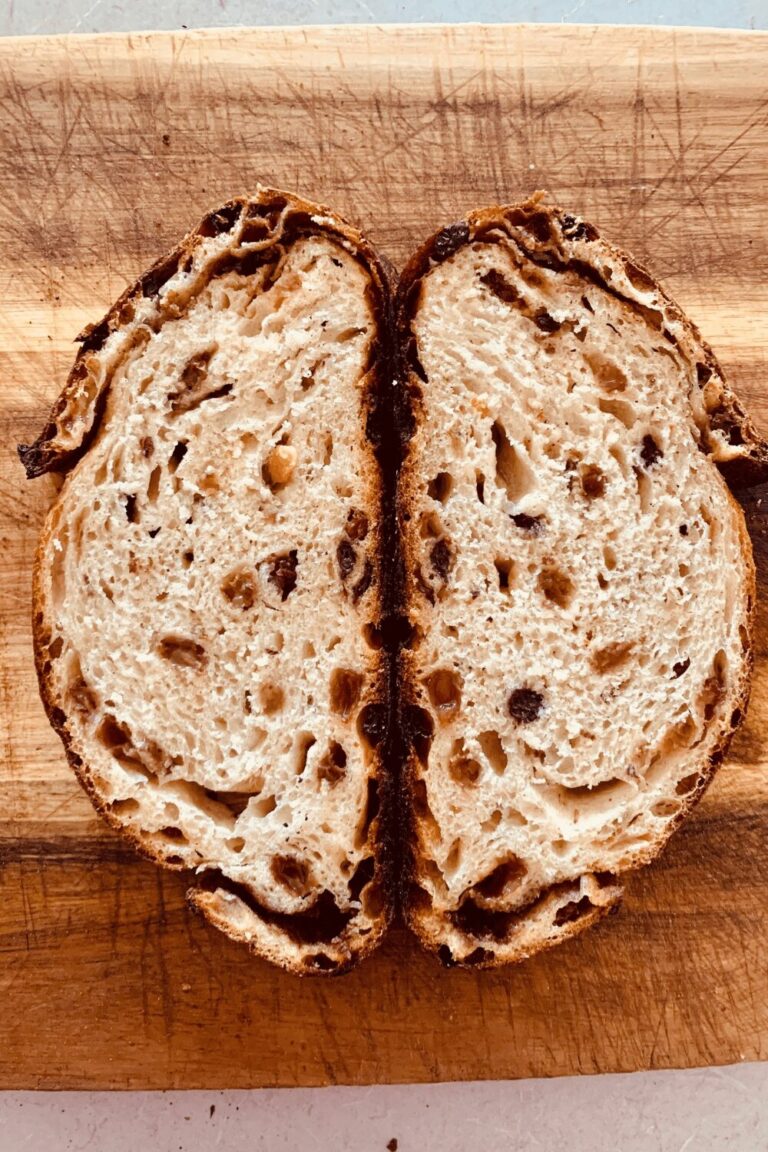Sourdough Sandwich Bread
This post may contain affiliate links.
One of the recipes I get asked for the most is a soft sourdough sandwich bread made in a loaf tin.
After trialling many inclusions and getting my family to vote on the best one, this easy recipe has become our family's go to soft sourdough sandwich loaf. Easy to bake and freeze, I'm sure you and your family will love it too!
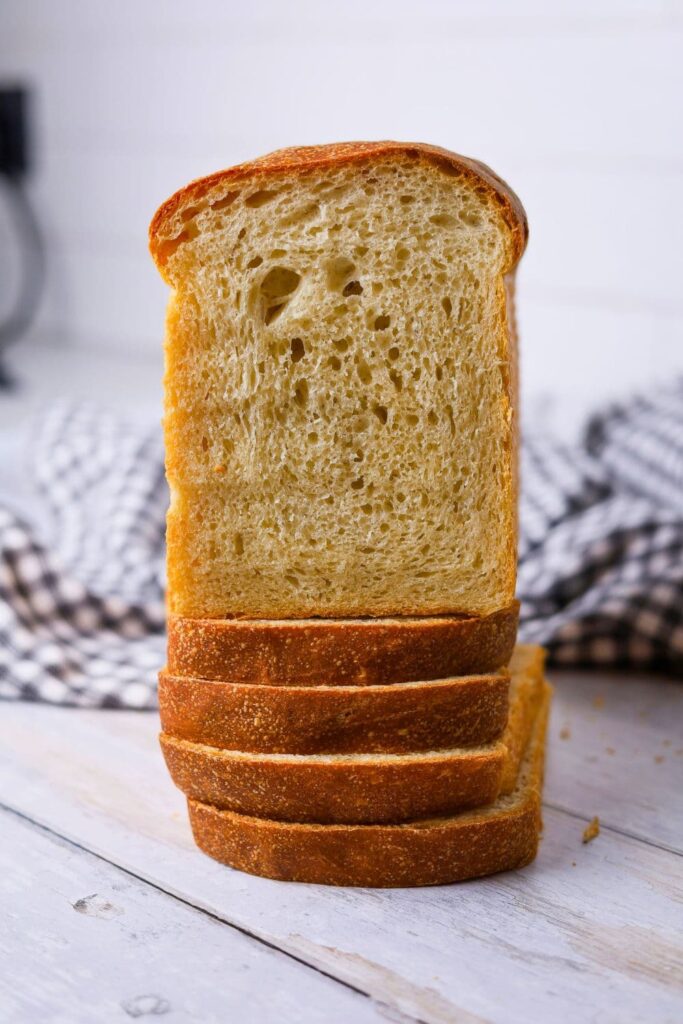
What Makes A Good Sourdough Sandwich Bread?
A good sourdough sandwich bread needs to have a closed crumb (so the fillings don't fall out) and a light airy texture. I personally like a softer crust on my sandwich bread, but you can certainly make a sandwich loaf with a crustier crust.
To give this sourdough sandwich bread it's light, airy crumb I've added some butter and sugar. The butter and sugar help to give the bread a softer crust, perfect for a sandwich loaf. Buttering the bread tin before you put the dough in helps to yield a softer golden crust.
You can add milk powder if you wish. It will give the bread a richer texture and more caramelised crust. After testing it a few times, my family and I prefer it without the milk powder, so I've chosen not to include it in this loaf.
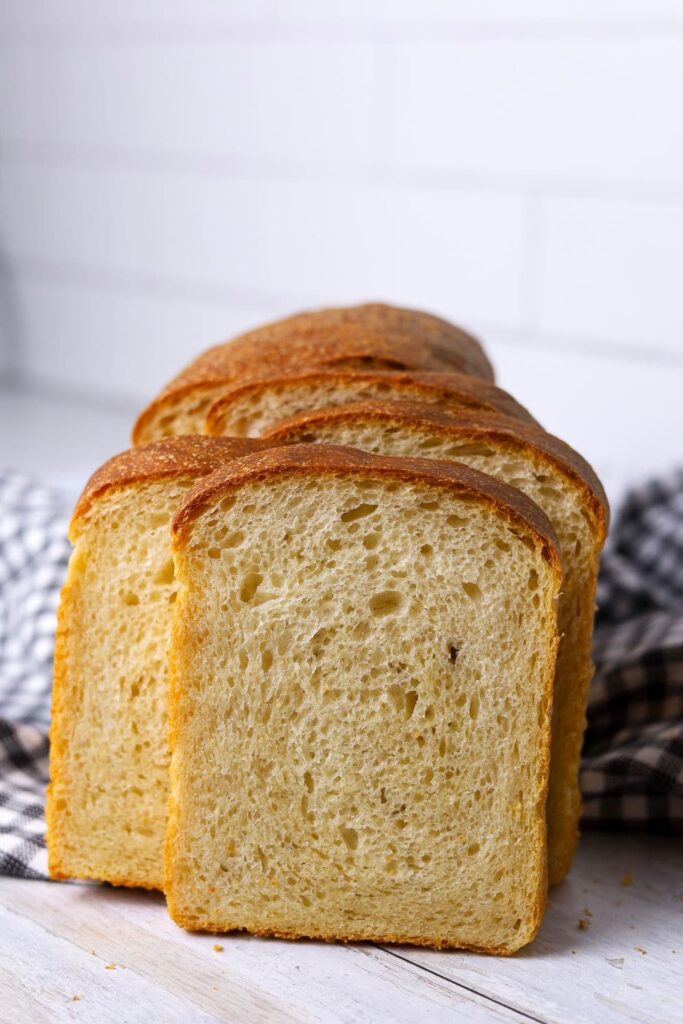
Choosing Your Amount of Starter
I generally use 100g of starter in this loaf and don't have any issues bulk fermenting overnight, so long as the temperature isn't above 21C.
If you want to leave your sandwich loaf to bulk ferment overnight (and it's a bit warmer where you live), I recommend using just 50g of starter.
You don't have to adjust anything else in the recipe. You can read about the effect of the starter amount on your sourdough here.
Hand Kneading vs Using A Mixer
This recipe is written using a stand mixer (or Thermomix). I like to use a mixer to mix the dough because it saves me loads of time (I have 3 kids so time is not my friend). There is no stretching and folding in this recipe (which is fantastic if you're short on time).
However, you can totally knead this sourdough sandwich loaf by hand with no issues. You'll need to knead the dough quite vigorously to incorporate all the butter and sugar but it's certainly possible!
Make sure that your dough is silky and elastic when you've finished kneading. Being an enriched dough it will not be sticky.
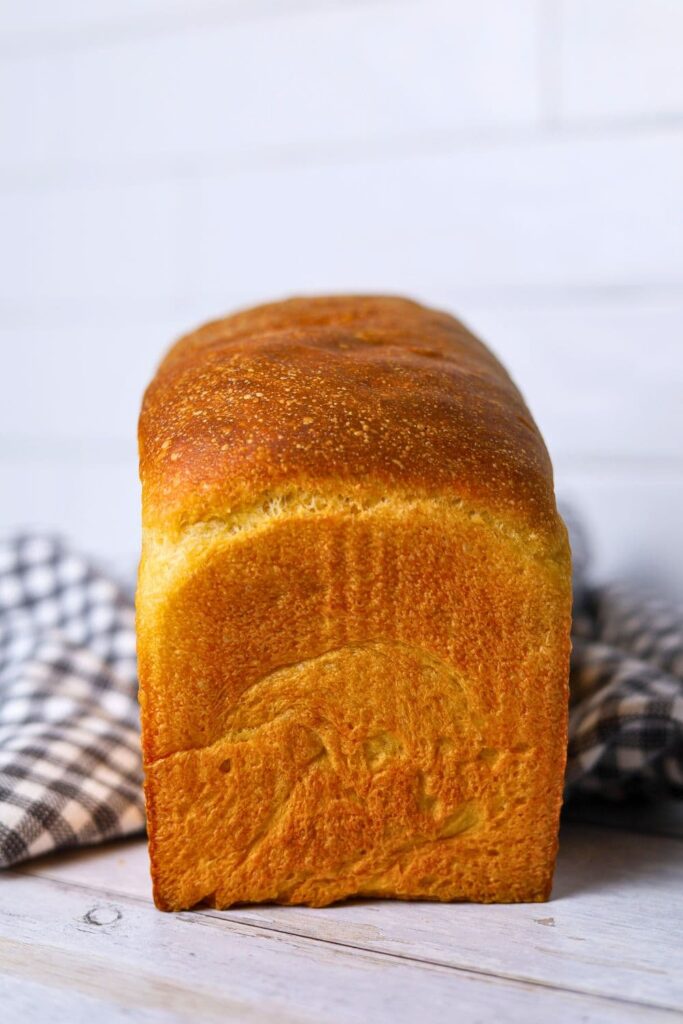
Bulk Fermentation & Letting Your Sandwich Loaf Rise
Sourdough sandwich bread differs from a traditional sourdough loaf in many ways. Not only is the crumb a lot tighter and the crust a lot thinner, it also does not need a "cold ferment" in the way that traditional sourdough does.
A sandwich loaf has a bulk ferment and then a "second rise" where it is left at room temperature after shaping to fill the tin. Once the loaf has filled the tin, you could place it in the fridge to bake at a later time (I wouldn't leave it more than 24 hours though). But generally it's better if you bake it straight away.
Which Loaf Tin Should You Choose?
Sandwich bread needs to be baked in a tin. You can use an open tin or a tin with a lid or "Pullman Bread Tin". If you use an open tin, you'll achieve a rounded top to your sandwich loaf. This is what I prefer to bake in.
You can however also use a Pullman Tin. This has a lid that slides on top and will yield you a square sandwich loaf, more like the bread you would buy in the supermarket.
No matter what type of tin you use, this loaf is best in a tin around 4 x 8 x 4 inches. This is the one I use (I just leave the lid off as I think it is nicer with the rounded top).
Shaping Sourdough Sandwich Bread
Shaping sandwich bread is so so easy. Of course, like anything, there are a million ways to complicate it, however I like to stick to this simple method - it's so easy my kids can do it!
You need to pop your fermented dough out onto the kitchen counter so that the smooth side is underneath and the sticky side is on the top. Gently ease the dough out into a rough rectangle, with the short edge closest to you.
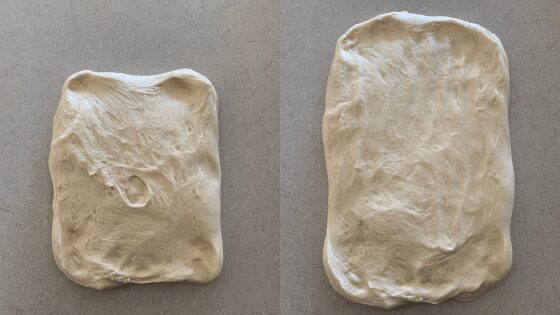
Pop any large bubbles and gently flatten the dough with your fingertips.
Then roll the dough up into a log and tuck the ends under.
Leave the dough to sit and relax for around 30 minutes. After 30 minutes, tighten up the log by pulling the dough a little, using the sticky underside to create tension.
Then simply plop the log into your buttered tin.
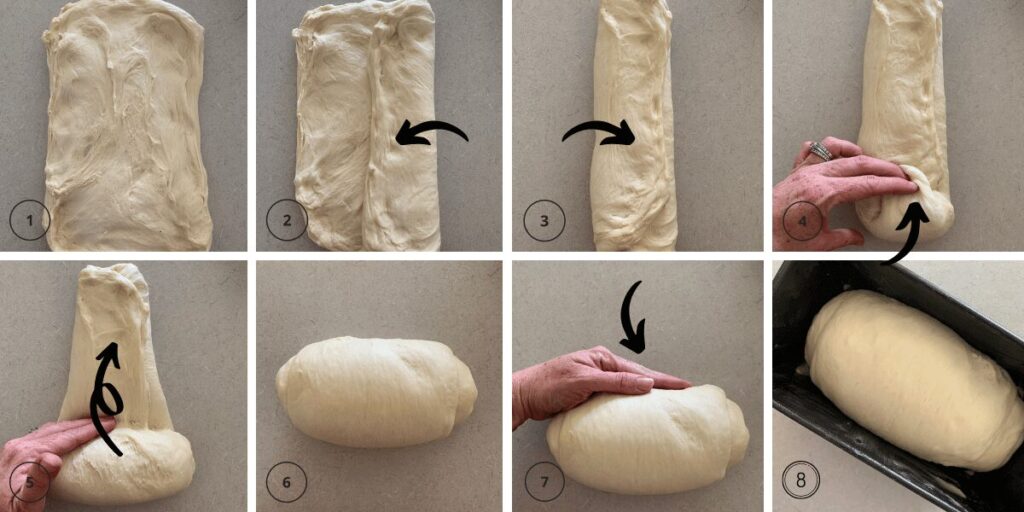
Unlike shaping a boule or batard, you really don't need to stress too much when it comes to shaping a sourdough sandwich loaf.
If you can get the top nice a tight, that's great. If you can't, it won't matter too much. The loaf will still puff up and be delicious!
Flavor Variations
While this recipe will never do you wrong, you can always add a few variations to make it a little more exciting! Try some of these:
- Replace the water with pineapple juice for a delicious variation.
- Honey & Oat Sandwich Loaf – Add 20g of honey and 50g of oats to the mixture when you add the butter, sugar and salt. If you’d like to add oats to the top you should do so when you put the dough into the tin – spray the loaf lightly with water so the oats stick to the top.
- Multigrain Sandwich Loaf – Add 50 to 100g of your favorite seeds to the mixture when you add the butter, sugar and salt. Seeds like sesame, sunflower, pumpkin and flax work really well.
Freezing Leftovers
You can easily double or even triple this recipe (when you look at the recipe below, you can easily click the button and it will automatically calculate the measurements for you).
Doubling the recipe means you can use one loaf and freeze the other. I like to make 3-4 loaves on a Sunday and freeze them for the rest of the week.
These plastic bread bags are perfect for freezing your sandwich bread in.
If you're a mama and you're making school lunches, this bread works so well! I even make a big batch of sandwiches and freeze them, making school mornings so much easier!
Things like ham and cheese, plain ham, peanut butter and jelly, honey or jam work the best when freezing. They defrost easily and you wouldn't even know they were frozen!
To store frozen sandwiches, you can place each sandwich in a plastic ziploc bag. This makes them easy to place in lunchboxes in the morning.
You could also wrap them in parchment paper and store in an airtight plastic container in the freezer if you don't want to use ziploc bags.
Slicing Sourdough Sandwich Loaf
Slicing a sandwich loaf can be tricky, especially if you want perfect slices. However, you can purchase a bread slicing guide which makes things much easier. You could even use an electric knife or electric food slicer. One of the most important things to do to ensure perfect, even slices is to let the sourdough sandwich loaf cool completely before slicing.
Equipment Needed
Sandwich Loaf Tins - you'll need a selection of sandwich loaf tins to bake your bread. Having 2 or even 4 is a great idea if you want to bake several loaves at once.
Plastic Bread Bags - these are a great way to store and freeze your bread and fantastic if you're making multiple loaves at once.
Bread Slicing Guide - these are super handy if you're wanting perfectly sliced sandwich bread.
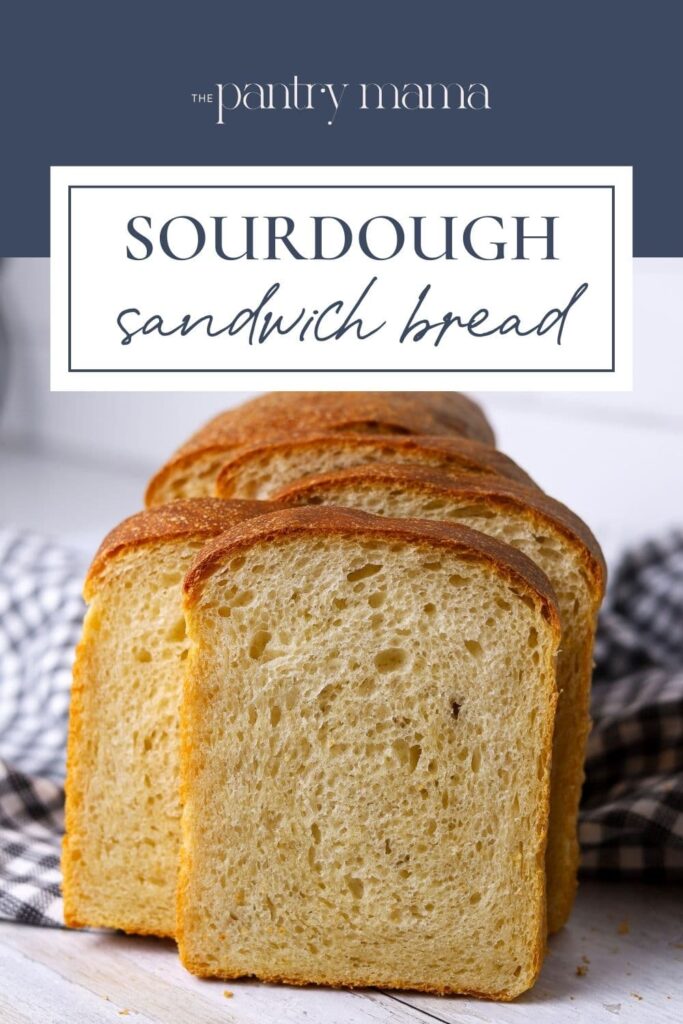
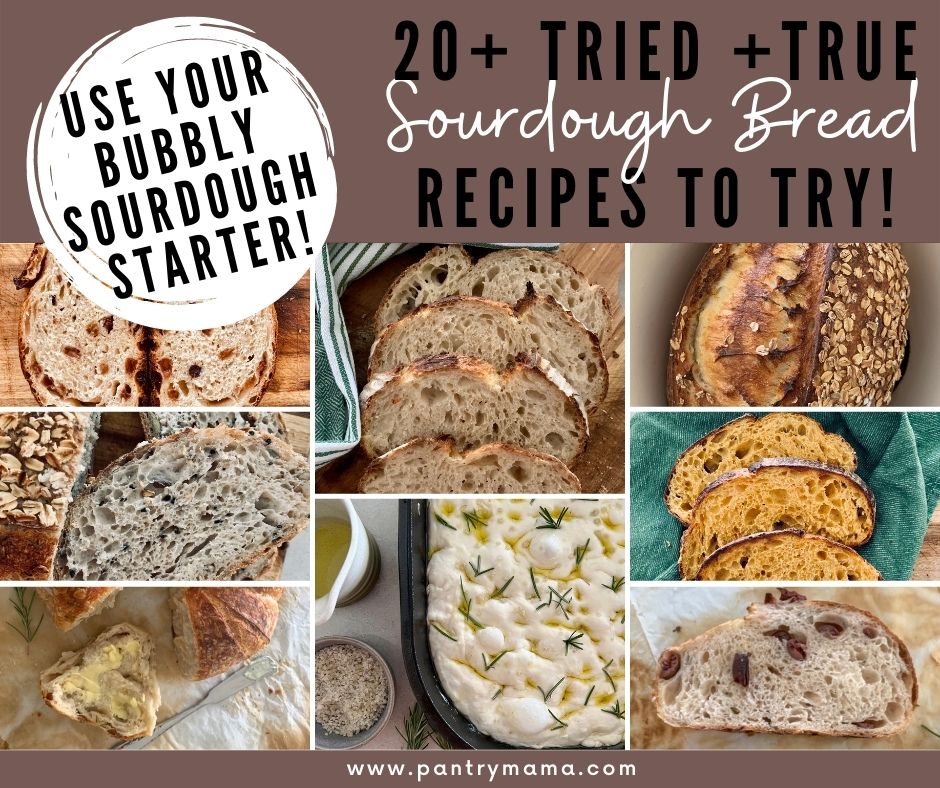
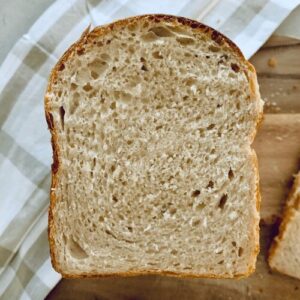
Sourdough Sandwich Bread Recipe
Equipment
- Stand Mixer
- Bread Tin
Ingredients
- 500 g Bread Flour
- 100 g Sourdough Starter fed and bubbly
- 280 g Water
- 60 g Butter Cubed
- 15 g Salt
- 20 g Sugar
Instructions
- Premix & Autolyse:Add your sourdough starter, flour and water into your stand mixer or Thermomix. Mix the ingredients for around 30 seconds until they are just combined into a shaggy dough. Leave to autolyse for around 30 minutes.Thermomix - dough mode 30 seconds.
- Now add the rest of your ingredients - salt, butter, sugar, (and milk powder if you're using it). Mix the ingredients for around 1 minute or until they are combined together. Now leave to rest for around 30 minutes.Thermomix - dough mode for 1 minute.
- Kneading Your Sandwich Dough:Using your stand mixer or Thermomix, knead the dough for around 3 minutes. If you are using a stand mixer, you'll need to use your dough hook. The dough should become very elastic. You won't be able to see the butter as it will be well combined into the dough. If the dough is getting a little warm from being mixed in the mixer, give it a 10 minute rest. If it seems ok, knead for the full 3 minutes. Now give your dough a 30 minute rest.Thermomix - dough mode for 3 minutes.
- Knead your dough in the mixer for another 2-3 minutes. You'll know it's ready when it is slapping the sides of the bowl of your Thermomix or Stand Mixer. The dough will be very elastic and quite silky and smooth. It shouldn't be sticking to the sides of the bowl at all. If it's not quite there, it's ok to knead for a few more minutes to develop the gluten and get it to where it needs to be.
- Bulk Ferment:Once your dough is kneaded sufficiently, you need to bulk ferment it. If you're using a stand mixer, it's fine to leave it in the mixing bowl. If you're using a Thermomix you'll need to tip your dough into a glass or ceramic bowl to finish its bulk ferment. At this point, you can just leave the dough as it is, covering it with some plastic wrap to stop it drying out. If you prefer your dough to be a bit neater, you can wet your hands and fold it into a neat ball.As with any sourdough bread, the bulk ferment time will depend on the temperature in your kitchen and of course the strength of your starter. You're looking for your dough to be just UNDER double.
- Shaping:Once your dough has finished its bulk ferment you can shape your dough. Before you start shaping, lightly butter your loaf tin.Ease your dough out of the bowl using a silicone dough scraper, remembering to have the smooth side on the counter and the sticky side facing up. You shouldn't need any flour for this as your dough shouldn't stick (it's such a beautiful silky, enriched dough).Gently ease your dough out into a rough rectangle, with the shortest side in front of you.Pop any large bubbles and gently flatten the dough using your fingertips. Then roll the dough up into a log (using the short side) and tuck the ends under. Leave the dough to sit and relax for around 30 minutes. After 30 minutes, tighten up the log by pulling the dough a little, using the sticky underside to create tension. Then simply plop the log into your buttered tin.
- Second Rise:Once your bread has been shaped and is in the tin, you'll need to let it rise again so that it fills up the shape of the tin. This should only take a few hours, but like the bulk ferment, this will depend on the strength of your starter and the temperature of your kitchen. You'll know it's done when it's risen above the lip of the tin (if you're using an open tin). It will be rounded on the top. When you poke it it will leave a slight indent but spring back nice and slowly. If you shaped it quite tight, you'll see some tension on the top of the dough as it's risen.
- Baking Your Sandwich Bread:Preheat your oven to around 180C/350F. Let your oven warm for around 10 minutes and then place your sandwich loaf in the oven and bake for approximately 40 minutes or until the top is golden brown. It may take a little longer depending on your oven. Once the loaf is baked, carefully place it on a rack to cool. Try to leave it at least one hour before you slice into it. If you have used milk powder in your dough, just watch the top of your loaf - if it's starting to burn, cover it in foil for the remainder of the bake.
- Once your dough is baked, remove it from the tin and leave to cool on a wire rack. Ideally, leave it for at least 90 minutes before you cut into it. Enjoy!
Nutrition



